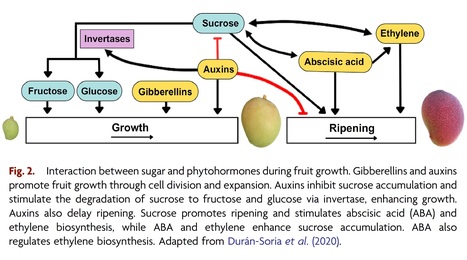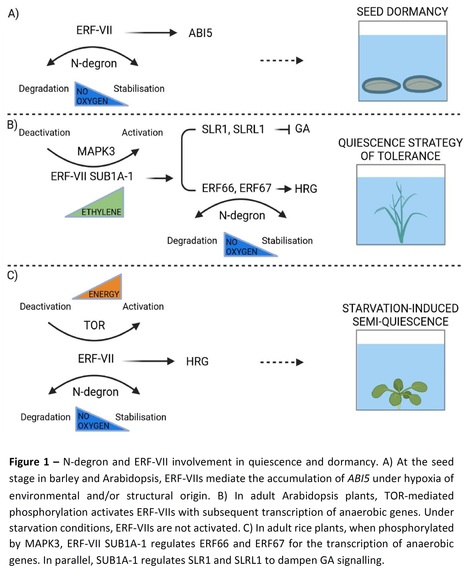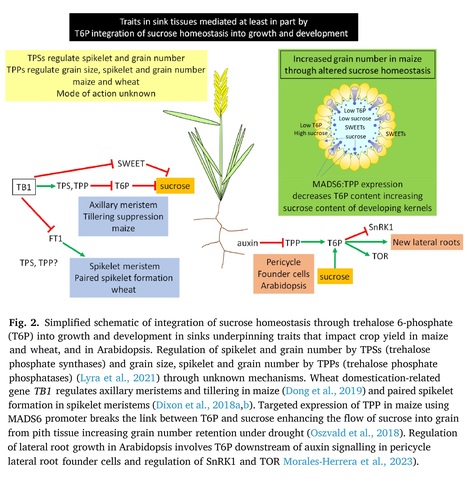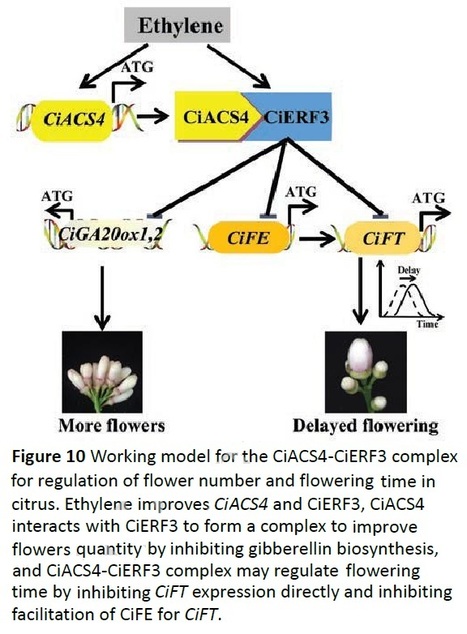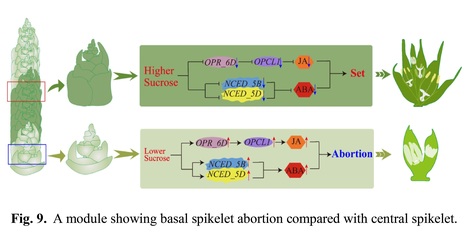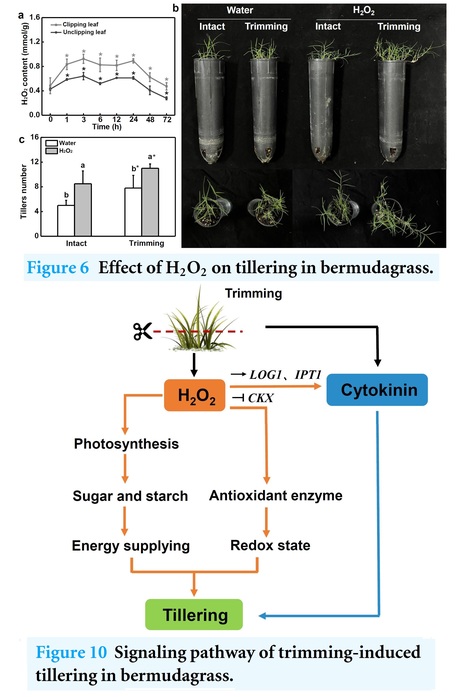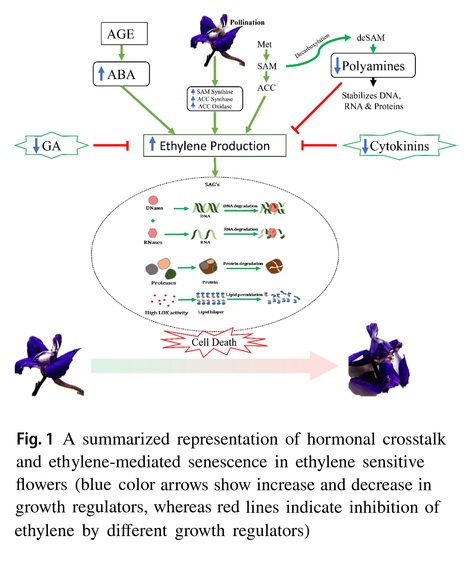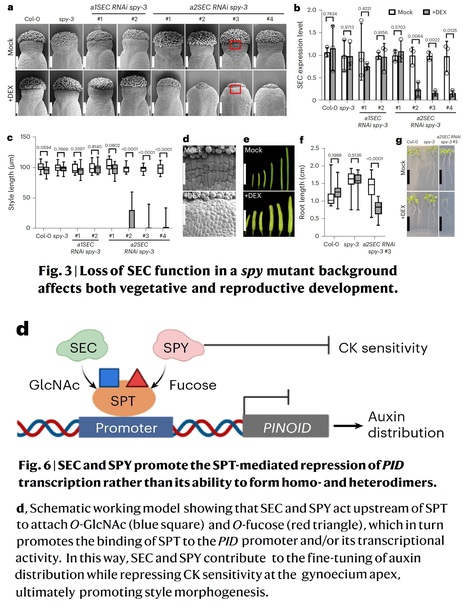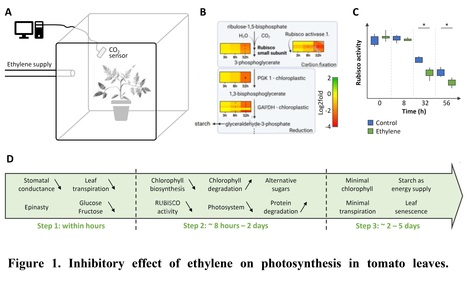 Your new post is loading...
 Your new post is loading...
Authors: Gerhard C. Rossouw, Ryan Orr, Dale Bennett and Ian S. E. Bally.
Functional Plant Biology (2024)
Abstract: "Reproductive development of fruiting trees, including mango (Mangifera indica L.), is limited by non-structural carbohydrates. Competition for sugars increases with cropping, and consequently, vegetative growth and replenishment of starch reserves may reduce with high yields, resulting in interannual production variability. While the effect of crop load on photosynthesis and the distribution of starch within the mango tree has been studied, the contribution of starch and sugars to different phases of reproductive development requires attention. This review focuses on mango and examines the roles of non-structural carbohydrates in fruiting trees to clarify the repercussions of crop load on reproductive development. Starch buffers the plant’s carbon availability to regulate supply with demand, while sugars provide a direct resource for carbon translocation. Sugar signalling and interactions with phytohormones play a crucial role in flowering, fruit set, growth, ripening and retention, as well as regulating starch, sugar and secondary metabolites in fruit. The balance between the leaf and fruit biomass affects the availability and contributions of starch and sugars to fruiting. Crop load impacts photosynthesis and interactions between sources and sinks. As a result, the onset and rate of reproductive processes are affected, with repercussions for fruit size, composition, and the inter-annual bearing pattern."
Authors: Chiara Pucciariello and Pierdomenico Perata.
Journal of Experimental Botany (2024)
Abstract: "Plant quiescence and seed dormancy can be triggered by reduced oxygen availability. Under water, oxygen depletion caused by flooding can culminate in a quiescent state, which is a plant strategy for energy preservation and survival. In adult plants, a quiescent state can be activated by sugar starvation, culminating in metabolic depression. In seeds, secondary dormancy can be activated by reduced oxygen availability, which creates an unfavourable state for germination. The physical dormancy of some seeds and buds includes barriers to external conditions, which indirectly results in hypoxia. The molecular processes that support seed dormancy and plant survival through quiescence under hypoxia include the N-degron pathway, which enables the modulation of ethylene responsive factors of group VII and downstream targets. This oxygen- and nitric oxide-dependent mechanism interacts with phytohormone-related pathways to control growth."
Authors: Takuya Yoshida, Julia Mergner, Zhenyu Yang, Jinghui Liu, Bernhard Kuster, Alisdair R. Fernie and Erwin Grill.
The Plant Journal (2024)
Abstract: "Phytohormones are essential signaling molecules regulating various processes in growth, development, and stress responses. Genetic and molecular studies, especially using Arabidopsis thaliana (Arabidopsis), have discovered many important players involved in hormone perception, signal transduction, transport, and metabolism. Phytohormone signaling pathways are extensively interconnected with other endogenous and environmental stimuli. However, our knowledge of the huge and complex molecular network governed by a hormone remains limited. Here we report a global overview of downstream events of an abscisic acid (ABA) receptor, REGULATORY COMPONENTS OF ABA RECEPTOR (RCAR) 6 (also known as PYRABACTIN RESISTANCE 1 [PYR1]-LIKE [PYL] 12), by integrating phosphoproteomic, proteomic and metabolite profiles. Our data suggest that the RCAR6 overexpression constitutively decreases the protein levels of its coreceptors, namely clade A protein phosphatases of type 2C, and activates sucrose non-fermenting-1 (SNF1)-related protein kinase 1 (SnRK1) and SnRK2, the central regulators of energy and ABA signaling pathways. Furthermore, several enzymes in sugar metabolism were differentially phosphorylated and expressed in the RCAR6 line, and the metabolite profile revealed altered accumulations of several organic acids and amino acids. These results indicate that energy- and water-saving mechanisms mediated by the SnRK1 and SnRK2 kinases, respectively, are under the control of the ABA receptor-coreceptor complexes."
Authors: Chenyu Rong, Renren Zhang, Yuexin Liu, Zhongyuan Chang, Ziyu Liu, Yanfeng Ding and Chengqiang Ding.
Plant Cell Reports (2024)
Key message: Purine permease PUP11 is essential for rice seed development, regulates the seed setting rate, and influences the cytokinin content, sugar transport, and starch biosynthesis during grain development.
Abstract: "The distribution of cytokinins in plant tissues determines plant growth and development and is regulated by several cytokinin transporters, including purine permease (PUP). Thirteen PUP genes have been identified within the rice genome; however, the functions of most of these genes remain poorly understood. We found that pup11 mutants showed extremely low seed setting rates and a unique filled seed distribution. Moreover, seed formation arrest in these mutants was associated with the disappearance of accumulated starch 10 days after flowering. PUP11 has two major transcripts with different expression patterns and subcellular locations, and further studies revealed that they have redundant positive roles in regulating the seed setting rate. We also found that type-A Response Regulator (RR) genes were upregulated in the developing grains of the pup11 mutant compared with those in the wild type. The results also showed that PUP11 altered the expression of several sucrose transporters and significantly upregulated certain starch biosynthesis genes. In summary, our results indicate that PUP11 influences the rice seed setting rate by regulating sucrose transport and starch accumulation during grain filling. This research provides new insights into the relationship between cytokinins and seed development, which may help improve cereal yield."
Authors: Jana Jarošová, Sylva Prerostova, Martin Černý, Petre Dobrev, Alena Gaudinova, Vojtech Knirsch, Eva Kobzová, Karel Müller, Roman Fiala, Kinga Benzcúr, Gabriella Szalai, Jan Novák, Břetislav Brzobohatý, Ondrej Novak and Radomira Vankova.
Environmental and Experimental Botany (2024)
Highlights: • Targeted stresses affected proteins predominantly in the non-exposed organs • Abscisic acid in roots after all cold treatments regulated hydraulic conductivity • Jasmonates in stressed leaves might diminish stress effects on photosynthesis • Salicylic acid probably enhanced sugar unloading from phloem in roots under stress • Pre-acclimation enhanced stress tolerance, and speeded up recovery
Abstract: "Rice is a plant species sensitive to cold stress, which renders seriously its cultivation. Responses to cold stress (5°C, 24 hours) in whole plants, or targeted to rice leaves or roots were followed at the hormonome, transcriptome, proteome, and sugar levels, to find organ-specific responses and processes affected by cold acclimation. Targeted stresses caused proteomic changes mainly in the unexposed organs. An increase in abscisic acid (ABA) was accompanied by a decrease in jasmonic acid (JA) (in roots and non-stressed leaves) and vice versa (JA increased in stressed leaves). Both hormones promote the cold tolerance of plants. In this way, JA could indirectly reduce negative effects of cold on photosynthesis in leaves, while ABA dominates in roots (stimulation of protective substances, especially dehydrins, control of water regime). The decrease in cytokinins trans-zeatin and dihydrozeatin in crowns correlated with stress-induced growth suppression. Leaf-targeted cold stress impaired photosynthesis and decreased sugar levels, diminishing their transport, which correlated with an increase in salicylic acid, which is a signal for sugar unloading from phloem into roots. Root-targeted stress suppressed cytokinin biosynthesis and upward transport, and promoted sugar accumulation in leaves. Acclimation per se activated the transcriptome and proteome response to cold –ABA, JA and ethylene were upregulated, moderately suppressing plant growth. Pre-acclimated plants showed less profound hormonal changes than directly stressed plants, positively affecting levels of growth-related phytohormones in the unexposed organs (cytokinins in roots of leaf-stressed plants; auxins in leaves of root-stressed plants)."
Authors: Zhaoheng Lin, Pan Zhu, Liyang Gao, Xuanyi Chen, Meijing Li, Yuhe Wang, Junxian He, Ying Miao and Rui Miao.
Plant and Cell Physiology (2024)
Abstract: "The polyhydroxylated steroid phytohormone brassinosteroids (BRs) control many aspects of plant growth, development and responses to environmental changes. Plasma membrane (PM) H+-ATPase, the well-known PM proton pump, is a central regulator in plant physiology, which mediates not only plant growth and development, but also adaptation to stresses. Recent studies highlight that PM H+-ATPase is at least partly regulated via the BR signaling. Firstly, the BR cell surface receptor BRASSINOSTEROID-INSENSITIVE 1 (BRI1) and multiple key components of BR signaling directly or indirectly influence PM H+-ATPase activity. Secondly, the SMALL AUXIN UP RNA (SAUR) gene family physically interacts with BRI1 to enhance organ development of Arabidopsis by activating PM H+-ATPase. Thirdly, RNA-sequencing (RNA-seq) assays showed that the expression of some SAUR genes is upregulated under the light or sucrose conditions, which is related to the phosphorylation state of the penultimate residue of PM H+-ATPase in a time-course manner. In this review, we describe the structural and functional features of PM H+-ATPase, and summarize recent progress toward understanding the regulatory mechanism of PM H+-ATPase by BRs, and briefly introduce how PM H+-ATPase activity is modulated by its own biterminal regions and the post-translational modifications."
Authors: Morgan Vanderwall and Joshua M. Gendron.
Development (2023)
Summary: HEXOKINASE1 is a crucial regulator of plant development. In this Spotlight, we discuss the vital role of HEXOKINASE1 catalytic activity and glucose-6-phosphate production in plant growth and senescence.
Abstract: "As photoautotrophic organisms, plants produce an incredible spectrum of pigments, anti-herbivory compounds, structural materials and energic intermediates. These biosynthetic routes help plants grow, reproduce and mitigate stress. HEXOKINASE1 (HXK1), a metabolic enzyme and glucose sensor, catalyzes the phosphorylation of hexoses, a key introductory step for many of these pathways. However, previous studies have largely focused on the glucose sensing and signaling functions of HXK1, and the importance of the enzyme's catalytic function is only recently being connected to plant development. In this brief Spotlight, we describe the developmental significance of plant HXK1 and its role in plant metabolic pathways, specifically in glucose-6-phosphate production. Furthermore, we describe the emerging connections between metabolism and development and suggest that HXK1 signaling and catalytic activity regulate discrete areas of plant development."
Authors: Javier A. Miret, Cara A. Griffiths and Matthew J. Paul.
Journal of Plant Physiology (2024)
Abstract: "Sugar homeostasis is a critical feature of biological systems. In humans, raised and dysregulated blood sugar is a serious health issue. In plants, directed changes in sucrose homeostasis and allocation represent opportunities in crop improvement. Plant tissue sucrose varies more than blood glucose and is found at higher concentrations (cytosol and phloem ca. 100 mM v 3.9–6.9 mM for blood glucose). Tissue sucrose varies with developmental stage and environment, but cytosol and phloem exhibit tight sucrose control. Sucrose homeostasis is a consequence of the integration of photosynthesis, synthesis of storage end-products such as starch, transport of sucrose to sinks and sink metabolism. Trehalose 6-phosphate (T6P)-SnRK1 and TOR play central, still emerging roles in regulating and coordinating these processes. Overall, tissue sucrose levels are more strongly related to growth than to photosynthesis. As a key sucrose signal, T6P regulates sucrose levels, transport and metabolic pathways to coordinate source and sink at a whole plant level. Emerging evidence shows that T6P interacts with meristems. With careful targeting, T6P manipulation through exploiting natural variation, chemical intervention and genetic modification is delivering benefits for crop yields. Regulation of cereal grain set, filling and retention may be the most strategically important aspect of sucrose allocation and homeostasis for food security."
Authors; Kohji Yamada and Akira Mine.
Science Advances (2024)
One-sentence summary: In plants, the types and amplitudes of defense outputs against bacterial and fungal pathogens depend on cellular sugars.
Abstract: "Pathogen recognition triggers energy-intensive defense systems. Although successful defense should depend on energy availability, how metabolic information is communicated to defense remains unclear. We show that sugar, especially glucose-6-phosphate (G6P), is critical in coordinating defense in Arabidopsis. Under sugar-sufficient conditions, phosphorylation levels of calcium-dependent protein kinase 5 (CPK5) are elevated by G6P-mediated suppression of protein phosphatases, enhancing defense responses before pathogen invasion. Subsequently, recognition of bacterial flagellin activates sugar transporters, leading to increased cellular G6P, which elicits CPK5-independent signaling promoting synthesis of the phytohormone salicylic acid (SA) for antibacterial defense. In contrast, while perception of fungal chitin does not promote sugar influx or SA accumulation, chitin-induced synthesis of the antifungal compound camalexin requires basal sugar influx activity. By monitoring sugar levels, plants determine defense levels and execute appropriate outputs against bacterial and fungal pathogens. Together, our findings provide a comprehensive view of the roles of sugar in defense."
Authors: Le-Le Chu, Wei-Xuan Zheng, Hai-Qiang Liu, Xing-Xing Sheng, Qing-Ye Wang, Yue Wang, Chun-Gen Hu and Jin-Zhi Zhang.
Plant Physiology (2024)
Abstract: "Flowering is an essential process in fruit trees. Flower number and timing have a substantial impact on the yield and maturity of fruit. Ethylene and gibberellin play vital roles in flowering, but the mechanism of coordinated regulation of flowering in woody plants by gibberellin and ethylene is still unclear. In this study, a lemon (Citrus limon L. Burm) 1-aminocyclopropane-1-carboxylic acid synthase gene (CiACS4) was overexpressed in Nicotiana tabacum and resulted in late flowering and increased flower number. Further transformation of citrus revealed that ethylene and starch content increased, and soluble sugar content decreased in 35S:CiACS4 lemon. Inhibition of CiACS4 in lemon resulted in effects opposite to that of 35S:CiACS4 in transgenic plants. Overexpression of the CiACS4-interacting protein ETHYLENE RESPONSE FACTOR3 (CiERF3) in Nicotiana tabacum resulted in delayed flowering and more flowers. Further experiments revealed that the CiACS4-CiERF3 complex can bind the promoters of FLOWERING LOCUS T (CiFT) and GOLDEN2−LIKE (CiFE) and suppress their expression. Moreover, overexpression of CiFE in Nicotiana tabacum led to early flowering and decreased flowers, and ethylene, starch, and soluble sugar contents were opposite to those in 35S:CiACS4 transgenic plants. Interestingly, CiFE also bound the promoter of CiFT. Additionally, GA3 and ACC treatments delayed flowering in adult citrus, and treatment with gibberellin and ethylene inhibitors increased flower number. ACC treatment also inhibited the expression of CiFT and CiFE. This study provides a theoretical basis for the application of ethylene to regulate flower number and mitigate the impacts of extreme weather on citrus yield due to delayed flowering."
Authors: Linhui Zhu, Yuwu Liao, Kai Lin, Wenfei Wu, Lanjuan Duan, Pan Wang, Xian Xiao, Tingting Zhang, Xin Chen, Jianzhong Wang, Kaiqin Ye, Hao Hu, Zeng-Fu Xu and Jun Ni.
Tree Physiology (2024)
Abstract: "Anthocyanins are flavonoid-like substances that play important roles in plants in adaptation to various environmental stresses. In this research, we discovered that cytokinin (CK) alone could effectively induce the anthocyanin biosynthesis in Eucalyptus and many other perennial woody plant species, but not in tobacco and Arabidopsis, suggesting a diverse role of CK in regulating anthocyanin biosynthesis in different species. Transcriptomic and metabolomic strategies were used to further clarify the specific role of CK in regulating anthocyanin biosynthesis in Eucalyptus. The results showed that 801 and 2241 genes were differentially regulated at 6 and 24 h, respectively, after CK treatment. Pathway analysis showed that most of the differentially expressed genes were categorized into pathways related to cellular metabolism or transport of metabolites, including amino acids and sugars. The metabolomic results well supported the transcriptome data, which showed that most of the differentially regulated metabolites were related to the metabolism of sugar, amino acids, and flavonoids. Moreover, CK treatment significantly induced the accumulation of sucrose in the CK-treated leaves, while sugar starvation mimicked by either defoliation or shading treatment of the basal leaves significantly reduced the sugar increase of the CK-treated leaves, and thus inhibited CK-induced anthocyanin biosynthesis. The results of in vitro experiment also suggested that CK-induced anthocyanin in Eucalyptus was sugar-dependent. Furthermore, we identified an early CK-responsive transcription factor MYB113 in Eucalyptus, the expression of which was significantly upregulated by CK treatment in Eucalyptus but inhibited in Arabidopsis. Importantly, overexpression of EgrMYB113 in the Eucalyptus hairy roots was associated with significant anthocyanin accumulation, and upregulation of most of the anthocyanin biosynthetic genes. In conclusion, our study demonstrates a key role of CK in the regulation of anthocyanin biosynthesis in Eucalyptus, providing a molecular basis for further understanding the regulatory mechanism, and diversity of hormone-regulated anthocyanin biosynthesis in different plant species."
Authors: Yu Lin, Meng Liang, Hao Pang, Zilong Wang, Hai Bi, Yutuo Wei and Liqin Du.
Journal of Agricultural and Food Chemistry (2024)
Abstract: "Gibberellins (GAs) are plant hormones widely used in agriculture. At present, GAs are produced by fermentation of the fungus Fusarium fujikuroi. However, fungal growth is too slow, resulting in slow fungal fermentation and a low yield. Here, to develop an alternative production source of GAs, an artificial pathway was engineered in Escherichia coli. By selecting and combining enzymes derived from plants and bacteria, a novel 4-enzyme pathway was successfully constructed to produce GAs using steviol, a readily available and less valuable byproduct during enzymatic refining of rebaudioside A, as a feedstock. Whole-cell biotransformation with E. coli strain expressing the novel pathway produced 71.17 ± 2.00 mg/L GA1 and a trace amount of GA3 from steviol in 48 h. This report presents a significant advancement in the fast production of GAs and establishes a method for the metabolism of terpenoids to produce target products in microbial hosts."
Authors: Wan Sun, Chongjing Lu, Liangyun Wen, Yaqun Liu, Xiaohan Zhou, Xuechen Xiao, Xiaolei Guo, Zhimin Wang, Zhencai Sun, Zhen Zhang and Yinghua Zhang.
Journal of Experimental Botany (2024)
Abstract: "Within a spike of wheat, central spikelet usually generates 3-4 fertile florets, while basal spikelet hardly achieves it; in fact, the physiological and transcriptional mechanism behind the difference in fertility between basal and central spikelet is unclear. This study reports a high temporal-resolution investigation of transcriptomes, number and morphology of floret primordia and physiological traits. The W6.5-W7.5 stage was regarded as a boundary domain to distinguish between fertile and abortive potential of floret primordia; those floret primordia reaching the W6.5-7.5 stage during differentiation phase (3-9 days after terminal spikelet stage, DAT) usually developed into fertile florets in the next dimorphism phase (12-27 DAT), whereas the others aborted. Central spikelet had a greater number of fertile florets than basal spikelet, which was associated with more floret primordia reaching the W6.5-7.5 stage. Physiological and transcriptional results demonstrated that central spikelet had a higher sucrose content, lower abscisic acid (ABA) and jasmonic acid (JA) accumulation than basal spikelet due to down-regulation of genes involved in ABA and JA synthesis. Collectively, we proposed a model in which ABA and JA accumulation was induced under limiting sucrose availability (basal spikelet) through up-regulating genes involved in ABA and JA synthesis; this led to floret primordia in basal spikelet hardly to reach fertile potential (W6.5-7.5 stage) during differentiation phase and then aborted. This fertility repression module may also regulate spikelet fertility in other cereal crops and potentially provide genetic resources to improve spikelet fertility."
|
Authors: Muhmmad Asad Ullah Asad, Zhang Yan, Lujian Zhou, Xianyue Guan and Fangmin Cheng.
Plant Physiology and Biochemistry (2024)
Highlights: • Sugars play an essential role in the regulations of leaf senescence. • Abiotic stresses trigger sugar signaling by inducing reactive oxygen species burst. • Sugar signaling interact with plant hormones and protein kinase to regulates leaf senescence. • Abiotic stresses target sugar signaling to regulate photosynthesis inhibition and programmed cell death (PCD).
Abstract: "Plants have evolved the adaptive capacity to mitigate the negative effect of external adversities at chemical, molecular, cellular, and physiological levels. This capacity is conferred by triggering the coordinated action of internal regulatory factors, in which sugars play an essential role in the regulating chloroplast degradation and leaf senescence under various stresses. In this review, we summarize the recent findings on the senescent-associated changes in carbohydrate metabolism and its relation to chlorophyll degradation, oxidative damage, photosynthesis inhibition, programmed cell death (PCD), and sink-source relation as affected by abiotic stresses. The action of sugar signaling in regulating the initiation and progression of leaf senescence under abiotic stresses involves interactions with various plant hormones, reactive oxygen species (ROS) burst, and protein kinases. This discussion aims to elucidate the complex regulatory network and molecular mechanisms that underline sugar-induced leaf senescence in response to various abiotic stresses. The imperative role of sugar signaling in regulating plant stress responses potentially enables the production of crop plants with modified sugar metabolism. This, in turn, may facilitate the engineering of plants with improved stress responses, optimal life span and higher yield achievement."
Authors: Zhichao Sun, Xinmiao Guo, R.M. Saravana Kumar, Chunying Huang, Yan Xie, Meng Li and Jisheng Li.
Plant Science (2024)
Highlights: • Late stage of mulberry fruit ripening witnessed ethylene accumulation and physiological changes. • Late stage fruit ripening-specific differentially expressed genes and associated metabolic pathways highlighted. • Transcriptome and metabolome data interconnects ethylene signaling and mulberry fruit ripening. • MaERF3 are important for ripening process.
Abstract: "Mulberry (Morus alba L.) is a climacteric and highly perishable fruit. Ethylene has been considered to be an important trigger of fruit ripening process. However, the role of ethylene in the mulberry fruit ripening process remains unclear. In this study, we performed a comprehensive analysis of metabolomic and transcriptomic data of mulberry fruit and the physiological changes accompanying the fruit ripening process. Our study revealed that changes in the accumulation of specific metabolites at different stages of fruit development and ripening were closely correlated to transcriptional changes as well as underlying physiological changes and the development of taste biomolecules. The ripening of mulberry fruits was highly associated with the production of endogenous ethylene, and further application of exogenous ethylene assisted the ripening process. Transcriptomic analysis revealed that differential expression of diverse ripening-related genes was involved in sugar metabolism, anthocyanin biosynthesis, and cell wall modification pathways. Network analysis of transcriptomics and metabolomics data revealed that many transcription factors and ripening-related genes were involved, among which ethylene-responsive transcription factor 3 (MaERF3) plays a crucial role in the ripening process. The role of MaERF3 in ripening was experimentally proven in a transient overexpression assay in apples. Our study indicates that ethylene plays a vital role in modulating mulberry fruit ripening. The results provide a basis for guiding the genetic manipulation of mulberry fruits towards sustainable agricultural practices and improve post-harvest management, potentially enhancing the quality and shelf life of mulberry fruits for sustainable agriculture and forestry."
Abstract: "Cold stress severely restricts growth and development, reduces yields, and impairs quality in tomatoes (Solanum lycopersicum). Amylase-associated starch degradation and soluble sugar accumulation have been implicated in adaptation and resistance to abiotic stress. Here, we report a β-amylase (BAM) gene, SlBAM3, which plays a central role in tomato cold tolerance. The expression of SlBAM3 was triggered by cold stress. SlBAM3 knockout using the CRISPR/Cas9 system retarded starch degradation and reduced soluble sugar accumulation in tomato plants, eventually attenuating cold tolerance. Expression analysis revealed that the SlBAM3 transcript level was boosted by MeJA. Furthermore, MYC2, an essential component of the JA signaling pathway, could bind to the SlBAM3 promoter and directly activate SlBAM3 transcription, as revealed by yeast one-hybrid and dual LUC assays. In addition, the suppression of MYC2 resulted in increased starch accumulation, decreased soluble sugar content, and reduced tolerance to cold stress in tomato plants. Taken together, these findings demonstrate that JA positively regulates β-amylase-associated starch degradation through the MYC2-SlBAM3 module in tomato during cold stress. The results of the present work expand our understanding of the mechanisms underlying BAM gene activation and starch catabolism under cold stress. The regulatory module of SlBAM3 can be further utilized to breed tomato cultivars with enhanced cold tolerance."
"Regulation der Korngröße bei Weizen entdeckt"
Quelle: Pflanzenforschung.de (12.03.2024)
Durch Ausschalten des TabHLH489-Gens mit der Genschere CRISPR/Cas erhöht sich die Körnergröße und Ertrag von Brotweizen.
Auszüge: "Weizen ist die weltweit bedeutendste Getreideart nach Mais und die Erntemenge beträgt ca. 800 Millionen Tonnen im laufenden Wirtschaftsjahr 2023/24. Um die Versorgungssicherheit für die weiterwachsende Weltbevölkerung zu gewährleisten, sind in den kommenden Jahren deutliche Ertragssteigerungen notwendig. Chinesische Forscher haben dazu einen neuen Ansatz gefunden. Durch Genom-Editierung mit der Genschere CRISPR/Cas konnte das Team Weizenvarianten erzeugen, die höhere Erträge liefern. Im Fachmagazin Plant Biotechnology Journal erläutern die Forscher:innen, dass das Gen TabHLH489 eine Schlüsselrolle für die Korngröße spielt."
"Das Ausschalten des Gens für TabHLH489 und seinen homologen Genen mittels der Genschere CRISPR/Cas führte zu einer Zunahme der Kornlänge und des Korngewichts, während die Überexpression zu einer Abnahme beider Werte führte. Darüber hinaus konnten sie einen ganzen Regulationskomplex aufdecken: TaSnRK1α1, die α-katalytische Untereinheit des pflanzlichen Energiesensors SnRK1, interagierte mit TabHLH489 und phosphorylierte den Transkriptionsfaktor, um seinen Abbau zu induzieren und so die Entwicklung des Weizenkorns zu fördern. Eine Zuckerbehandlung induzierte ebenfalls die Anreicherung des TaSnRK1α1-Proteins und führte so zu einer Senkung des TabHLH489-Proteinspiegels..... Auch Brassinosteroide steuern die Korngröße - Darüber hinaus konnten die Forscher:innen zeigen, dass das Pflanzenhormon Brassinosteroid (BR) die Kornentwicklung fördert, indem es die TabHLH489-Expression über den Transkriptionsfaktor BRASSINAZOLE RESISTANT1 (BZR1) verringert. Eine weitere wichtige Beobachtung war, dass natürliche Variationen in der Promotorregion von TabHLH489 die BZR1-Bindungsfähigkeit beeinträchtigen und dadurch die TabHLH489-Expression beeinflussen. Insgesamt konnte die Studie damit den grundlegenden Regulationsmechanismus für die Korngröße bei Weizen aufklären: das TaSnRK1α1-TabHLH489-Regulationsmodul, das auch BR- und Zuckersignale integriert. Damit steht nun der Weg offen, gezielt Weizensorten mit erhöhter Korngröße und Ertrag zu züchten."
Authors: Shuang Li, Yanling Yin, Jianmin Chen, Xinyu Cui and Jinmin Fu.
PeerJ (2024)
Abstract: "Tillering/branching pattern plays a significant role in determining the structure and diversity of grass, and trimming has been found to induce tillering in turfgrass. Recently, it has been reported that hydrogen peroxide (H2O2) regulates axillary bud development. However, the role of H2O2 in trimming-induced tillering in bermudagrass, a kind of turfgrass, remains unclear. Our study unveils the significant impact of trimming on promoting the sprouting and growth of tiller buds in stolon nodes, along with an increase in the number of tillers in the main stem. This effect is accompanied by spatial-temporal changes in cytokinin and sucrose content, as well as relevant gene expression in axillary buds. In addition, the partial trimming of new-born tillers results in an increase in sucrose and starch reserves in their leaves, which can be attributed to the enhanced photosynthesis capacity. Importantly, trimming promotes a rapid H2O2 burst in the leaves of new-born tillers and axillary stolon buds. Furthermore, exogenous application of H2O2 significantly increases the number of tillers after trimming by affecting the expression of cytokinin-related genes, bolstering photosynthesis potential, energy reserves and antioxidant enzyme activity. Taken together, these results indicate that both endogenous production and exogenous addition of H2O2 enhance the inductive effects of trimming on the tillering process in bermudagrass, thus helping boost energy supply and maintain the redox state in newly formed tillers."
Authors: Aehsan ul Haq, Sumira Farooq, Mohammad Lateef Lone, Shazia Parveen, Foziya Altaf and Inayatullah Tahir
Journal of Plant Growth Regulation (2024)
Abstract: "Postharvest senescence of cut flowers is a stumbling impediment in harnessing their commercial potential. Consequently, the postharvest quality preservation of cut flowers is a crucial factor to allure buyers and maximize economic gains. Flower senescence being final phase of organ development is a key factor triggering postharvest quality deterioration. The process of flower senescence is closely regulated by developmental and environmental cues. The perception of these signals subsequently involves loss of membrane integrity, decreased activity of antioxidant enzymes, and upregulation of proteases and nucleases, which are key signatures of senescence and culminate in the death of petal tissues. Moreover, the developmental and environmental cues are synchronized by considerable turnover in different growth regulators, particularly cytokinins, abscisic acid, ethylene, and gibberellic acid, which act both antagonistically and synergistically to coordinate the senescence process in flowers. Among these growth regulators, ethylene has a crucial role in orchestrating petal senescence in ethylene-responsive systems, while, abscisic acid regulates petal senescence in ethylene-independent systems. Recent research on ethylene-sensitive flowers revealed that the crosstalk of ethylene with sugars and other growth regulators plays a crucial role in modulating senescence by affecting the expression of ethylene-responsive genes. Despite the plethora of postharvest studies conducted so far, considerable miss links still persist in understanding the intricacies of senescence regulating mechanisms, mainly in ethylene-responsive flowers. To this end, it is imperative to critically re-evaluate our current understanding of ethylene-dependent flower senescence to gain intricate inputs regarding the underlying senescence mechanisms, particularly in ornamental families like Ranunculaceae. This constitutes the pivotal gateway toward deciphering the enigmatic complexities governing senescence regulatory mechanisms, thereby forging a path for postharvest researchers to craft pioneering methodologies aimed at accentuating the longevity of commercially significant flowers, thereby yielding substantial economic ramifications."
Authors: Yi Zhang, Yingying Xing, Xinyu Tian, Liuhui Yang, Likai Wang, Zhiyong Guan, Jiafu Jiang, Fadi Chen and Sumei Chen.
Postharvest Biology and Technology (2024)
Highlights: • Sucrose antagonizes SL-induced leaf senescence in chrysanthemum. • Various genes antagonistically regulated by SL and sucrose were revealed by RNA-seq. • CmWRKY6-Like positively regulates leaf senescence in chrysanthemum. • CmWRKY6-Like involves the antagonistic regulation of leaf senescence by SL and sugar.
Abstract: "Strigolactone (SL), a novel plant hormone, plays a vital role in promoting leaf senescence. Sugar, a nutrient source widely used to retain freshness of cut flowers, was recently reported to alleviate SL-induced leaf senescence; however, the underlying molecular mechanisms remain unclear. Leaf senescence during transportation and storage of cut chrysanthemum considerably affects its shelf life and ornamental value. In this study, we found that sucrose antagonizes SL-induced leaf senescence in chrysanthemum. Transcriptional reprogramming analysis revealed a number of differentially expressed genes antagonistically regulated by SL and sucrose, mainly including those related to SL signaling, sugar signaling, ethylene, auxin, jasmonic acid, reactive oxygen species, chlorophyll metabolism pathways, and transcription factors (such as WRKY, NAC, AP2/ERF, and MYB). Virus-based transient silencing of CmWRKY6-Like in chrysanthemum revealed that CmWRKY6-Like positively regulates leaf senescence and involves the antagonistic regulation of leaf senescence by SL and sucrose. This study provides a basis for understanding the molecular mechanisms underlying the antagonistic roles of SL- and sugar-mediated leaf senescence in chrysanthemum."
Authors: Yuxiang Jiang, Seamus Curran-French, Samuel W. H. Koh, Iqra Jamil, Benguo Gu, Luca Argirò, Sergio G. Lopez, Carlo Martins, Gerhard Saalbach and Laila Moubayidin.
Nature Plants (2024)
Editor's view: The Arabidopsis O-glycosyltransferases SEC and SPY modify the transcription factor SPT and synergistically promote style elongation. Specific SPT residues modified by O-GlcNAc and O-fucose are essential for style radialization.
Abstract: "O-linked β-N-acetylglucosamine (O-GlcNAc) and O-fucose are two sugar-based post-translational modifications whose mechanistic role in plant signalling and transcriptional regulation is still largely unknown. Here we investigated how two O-glycosyltransferase enzymes of Arabidopsis thaliana, SPINDLY (SPY) and SECRET AGENT (SEC), promote the activity of the basic helix–loop–helix transcription factor SPATULA (SPT) during morphogenesis of the plant female reproductive organ apex, the style. SPY and SEC modify amino-terminal residues of SPT in vivo and in vitro by attaching O-fucose and O-GlcNAc, respectively. This post-translational regulation does not impact SPT homo- and heterodimerization events, although it enhances the affinity of SPT for the kinase PINOID gene locus and its transcriptional repression. Our findings offer a mechanistic example of the effect of O-GlcNAc and O-fucose on the activity of a plant transcription factor and reveal previously unrecognized roles for SEC and SPY in orchestrating style elongation and shape."
Authors: Marieke Dubois
Plant Physiology (2024)
Excerpt: "Altogether, the work performed by Mohorović and colleagues revealed the chronology of ethylene-mediated photosynthesis inhibition in young tomato leaves. Their approach defined a three-step response consisting of: (1) a reduction in the capture of CO2 and light, resulting in a rapid decline of soluble sugars, (2) a transcriptional down-regulation of genes related to photosynthesis, coupled to the up-regulation of genes necessary to gather energy from other sources, perhaps sucrose or proteins and (3) a long-term starch and chlorophyll breakdown resulting in leaf senescence (Figure 1D). Adding a time-factor to the extensively studied ethylene response is crucial, as hormones often affect temporary or dynamic processes (Waadt et al., 2022) that can only be detected by time-course experiments, as was elegantly performed in Mohorović et al., 2023. This work paves the way towards further molecular characterization of the regulatory cascades linking the different steps of the ethylene-mediated inhibition of photosynthesis."
Authors: Daxia Wu, Yanan Cao, Daojian Wang, Guoxinan Zong, Kunxu Han, Wei Zhang, Yanhua Qi, Guohua Xu and Yali Zhang.
Plant Physiology (2024)
One-sentence summary: Auxin transport inhibitor response 1 (TIR1) plays an essential role in rice grain yield and quality via modulating sugar transport into the endosperm.
Abstract: "Cereal endosperm represents the most important source of the world's food. Nevertheless, the molecular mechanisms behind sugar import into rice (Oryza sativa) endosperm and their relationship with auxin signaling are poorly understood. Here, we report that auxin transport inhibitor response 1 (TIR1) plays an essential role in rice grain yield and quality via modulating sugar transport into endosperm. The fluctuations of OsTIR1 transcripts parallel to the early stage of grain expansion among those of five TIR1/AFB (AFB, auxin-signaling F-Box) auxin co-receptor proteins. OsTIR1 is abundantly expressed in ovular vascular trace, nucellar projection, nucellar epidermis, aleurone layer cells, and endosperm, providing a potential path for sugar into the endosperm. Compared to wild-type (WT) plants, starch accumulation is repressed by mutation of OsTIR1 and improved by overexpression of the gene, ultimately leading to reduced grain yield and quality in tir1 mutants but improvement in overexpression lines. Of rice AUXIN RESPONSE FACTOR (ARF) genes, only the OsARF25 transcript is repressed in tir1 mutants and enhanced by overexpression of OsTIR1; its highest transcript is recorded at 10 d after fertilization, consistent with OsTIR1 expression. Also, OsARF25 can bind the promoter of sugar transporter OsSWEET11 (SWEET11, sugars will eventually be exported transporter) in vivo and in vitro. arf25 and arf25/sweet11 mutants exhibit reduced starch content and seed size (relative to the WTs), similar to tir1 mutants. Our data reveal that OsTIR1 mediates sugars import into endosperm via the auxin signaling component OsARF25 interacting with sugar transporter OsSWEET11. The results of this study are of great significance to further clarify the regulatory mechanism of auxin signaling on grain development in rice."
Authors: Petar Mohorović, Batist Geldhof, Kristof Holsteens, Marilien Rinia, Stijn Daems, Timmy Reijnders, Johan Ceusters, Wim Van den Ende and Bram Van de Poel.
Plant Physiology (2024)
Abstract: "Ethylene is a volatile plant hormone that regulates many developmental processes and responses towards (a)biotic stress. Studies have shown that high levels of ethylene repress vegetative growth in many important crops, including tomato (Solanum lycopersicum), possibly by inhibiting photosynthesis. We investigated the temporal effects of ethylene on young tomato plants using an automated ethylene gassing system to monitor the physiological, biochemical, and molecular responses through time-course RNA-seq of a photosynthetically active source leaf. We found that ethylene evokes a dose-dependent inhibition of photosynthesis, which can be characterized by three temporally distinct phases. The earliest ethylene responses that marked the first phase and occurred a few hours after the start of the treatment were leaf epinasty and a decline in stomatal conductance, which led to lower light perception and CO2 uptake, respectively, resulting in a rapid decline of soluble sugar levels (glucose, fructose). The second phase of the ethylene effect was marked by low carbohydrate availability, which modulated plant energy metabolism to adapt by using alternative substrates (lipids and proteins) to fuel the TCA cycle. Long-term continuous exposure to ethylene led to the third phase, characterized by starch and chlorophyll breakdown, which further inhibited photosynthesis, leading to premature leaf senescence. To reveal early (3 h) ethylene-dependent regulators of photosynthesis, we performed a ChIP-seq experiment using anti-ETHYLENE INSENSITIVE 3-like 1 (EIL1) antibodies and found several candidate transcriptional regulators. Collectively, our study revealed a temporal sequence of events that led to the inhibition of photosynthesis by ethylene and identified potential transcriptional regulators responsible for this regulation."
Authors: Thuan Duc Lao, Nguyen Hoai Nguyen, Thuy Ai Huyen Le and Phuong Dong Tran Nguyen.
Molecular Biotechnology (2024)
Abstract: "The melon (Cucumis melo L.), a fruit crop of significant economic importance, is prized for its sweet and succulent fruits. Among variations of soluble sugars, sucrose, a disaccharide composed of glucose and fructose, is a key carbohydrate present in melon fruits. The sucrose content also determines the quality and value of melon fruits. However, the accumulation of sucrose is a complex process involving the coordinated actions of multiple enzymes and pathways. In melon species, there are two types of fruit ripening modes including climacteric and non-climacteric. Due to this biological characteristic, melon is emerging as a good model for studying the ripening process. Ethylene is a well-known phytohormone regulating the ripening of climacteric fruits. Recently, a few studies have elucidated a primary ethylene-dependent signaling pathway of sucrose accumulation in melon fruits. This review aims to provide a careful overview of the sucrose biosynthesis pathways in melon. It is essential to understand the molecular mechanisms of sucrose metabolism as well as its regulation mode. The information will be useful for developing molecular marker-assisted breeding as well as genetic engineering strategies aiming to improve the sucrose content and quality of melon fruits. In addition, even though limited, the impacts of genetic background and environmental factors on sucrose accumulation in melon fruits are also discussed. These are useful for practical applications in melon cultivation and quality management."
|
 Your new post is loading...
Your new post is loading...
 Your new post is loading...
Your new post is loading...





